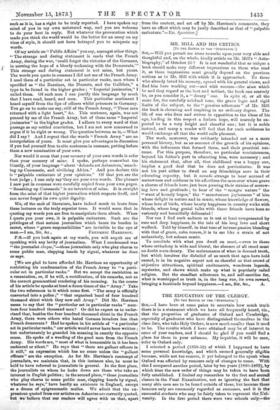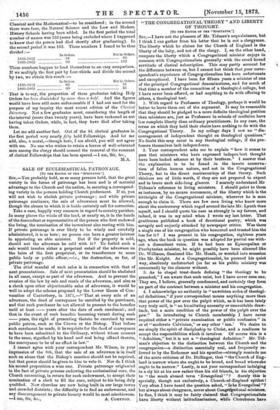THE EDUCATION OF THE CLERGY.
(TO THE EDITOR OF THE SPECTATOR.")
SIE, —I have been at some pains to ascertain how much truth there is in a statement which we have all frequently heard, viz., that the proportion of graduates of Oxford and Cambridge, especially of graduates who have distinguished themselves in the class-lists, who take Holy Orders, is now much smaller than it-used to be. The results which I have obtained may be of interest to some of your readers, and I should be glad if yoa could find a place for them in your columns. My inquiries, it will bo seen, refer to Oxford only.
I selected a period (1850-52) of which I happened to have some personal knowledge, and which seemed generally eligible because, while not too remote, it yet belonged to the epoch when Oxford was affected by rumours only of changes to come. With this I compared another period, later by ten years (1860-1862), by which time the new order of things may be taken to have been fully established. I limited my researches to the first and second classes in the Final Examination, not as ignoring the fact that many able men are to be found outside of these, but because these honours only are commonly regarded as successes, and it IS the successful students who may be fairly taken to represent the Uni- versity. In the first period there were two schools only—the
Classical and the Mathematical—to be considered ; in the second there were four, the Natural Science and the Law and Modern History Schools having been added. In the first period the total number of names was 152 (some being excluded where I happened to know that the person had died shortly after graduating). In the second period it was 162. These numbers I found to be thus divided :—
In Orders. Not in Orders.
1850-1852 84 68 1860-1862 GO 102
These numbers happen to lend themselves to an easy comparison. If we multiply the first pair by four-thirds and divide the second by two, we obtain this result :-
In Orders. Not in Orders.
1850-1850 62 51
1860-1862 30 51
That is to say, the proportion of these graduates taking Holy Orders has been diminished by more than a half. And the figures would have been still more unfavourable if I had not used for the purpose of my inquiry the most recent edition of the Clerical Directory. Not a few graduates must, considering the length of the interval (more than twenty years), have been reckoned as not having taken Orders, while, in fact, they have died after taking them.
Let me add another fact. Out of the 84 clerical graduates in the first period very nearly fifly held Fellowships. And let me add, also, a moral,—though here, I am afraid, you will not agree with me. No one who wishes to retain a leaven of well-educated men among the clergy should counsel the removal of the remnant of clerical Fellowships that has been spared.—I am, Sir, &c.,
M.A.



































 Previous page
Previous page